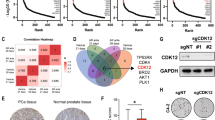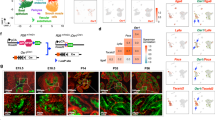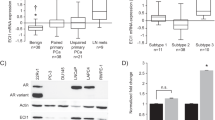Abstract
The androgen receptor (AR) is required for prostate cancer (PCa) survival and progression, and ablation of AR activity is the first line of therapeutic intervention for disseminated disease. While initially effective, recurrent tumors ultimately arise for which there is no durable cure. Despite the dependence of PCa on AR activity throughout the course of disease, delineation of the AR-dependent transcriptional network that governs disease progression remains elusive, and the function of AR in mitotically active cells is not well understood. Analyzing AR activity as a function of cell cycle revealed an unexpected and highly expanded repertoire of AR-regulated gene networks in actively cycling cells. New AR functions segregated into two major clusters: those that are specific to cycling cells and retained throughout the mitotic cell cycle ('Cell Cycle Common'), versus those that were specifically enriched in a subset of cell cycle phases ('Phase Restricted'). Further analyses identified previously unrecognized AR functions in major pathways associated with clinical PCa progression. Illustrating the impact of these unmasked AR-driven pathways, dihydroceramide desaturase 1 was identified as an AR-regulated gene in mitotically active cells that promoted pro-metastatic phenotypes, and in advanced PCa proved to be highly associated with development of metastases, recurrence after therapeutic intervention and reduced overall survival. Taken together, these findings delineate AR function in mitotically active tumor cells, thus providing critical insight into the molecular basis by which AR promotes development of lethal PCa and nominate new avenues for therapeutic intervention.
This is a preview of subscription content, access via your institution
Access options
Subscribe to this journal
Receive 50 print issues and online access
$259.00 per year
only $5.18 per issue
Buy this article
- Purchase on Springer Link
- Instant access to full article PDF
Prices may be subject to local taxes which are calculated during checkout







Similar content being viewed by others
References
Siegel RL, Miller KD, Jemal A . Cancer statistics, 2015. CA Cancer J Clin 2015; 65: 5–29.
Knudsen KE, Penning TM . Partners in crime: deregulation of AR activity and androgen synthesis in prostate cancer. Trends Endocrinol Metab 2010; 21: 315–324.
Knudsen KE, Scher HI . Starving the addiction: new opportunities for durable suppression of AR signaling in prostate cancer. Clin Cancer Res 2009; 15: 4792–4798.
Beekman KW, Hussain M . Hormonal approaches in prostate cancer: application in the contemporary prostate cancer patient. Urol Oncol 2008; 26: 415–419.
Knudsen KE, Kelly WK . Outsmarting androgen receptor: creative approaches for targeting aberrant androgen signaling in advanced prostate cancer. Expert Rev Endocrinol Metab 2011; 6: 483–493.
Yuan X, Balk SP . Mechanisms mediating androgen receptor reactivation after castration. Urol Oncol 2009; 27: 36–41.
Yuan X, Cai C, Chen S, Chen S, Yu Z, Balk SP . Androgen receptor functions in castration-resistant prostate cancer and mechanisms of resistance to new agents targeting the androgen axis. Oncogene 2014; 33: 2815–2825.
Barfeld SJ, Itkonen HM, Urbanucci A, Mills IG . Androgen-regulated metabolism and biosynthesis in prostate cancer. Endocr Relat Cancer 2014; 21: T57–T66.
Massie CE, Lynch A, Ramos-Montoya A, Boren J, Stark R, Fazli L et al. The androgen receptor fuels prostate cancer by regulating central metabolism and biosynthesis. EMBO J 2011; 30: 2719–2733.
Xu Y, Chen SY, Ross KN, Balk SP . Androgens induce prostate cancer cell proliferation through mammalian target of rapamycin activation and post-transcriptional increases in cyclin D proteins. Cancer Res 2006; 66: 7783–7792.
Wang Q, Li W, Zhang Y, Yuan X, Xu K, Yu J et al. Androgen receptor regulates a distinct transcription program in androgen-independent prostate cancer. Cell 2009; 138: 245–256.
Waltering KK, Helenius MA, Sahu B, Manni V, Linja MJ, Janne OA et al. Increased expression of androgen receptor sensitizes prostate cancer cells to low levels of androgens. Cancer Res 2009; 69: 8141–8149.
Nelson PS, Clegg N, Arnold H, Ferguson C, Bonham M, White J et al. The program of androgen-responsive genes in neoplastic prostate epithelium. Proc Natl Acad Sci USA 2002; 99: 11890–11895.
Sharma A, Yeow WS, Ertel A, Coleman I, Clegg N, Thangavel C et al. The retinoblastoma tumor suppressor controls androgen signaling and human prostate cancer progression. J Clin Invest 2010; 120: 4478–4492.
Mallik I, Davila M, Tapia T, Schanen B, Chakrabarti R . Androgen regulates Cdc6 transcription through interactions between androgen receptor and E2F transcription factor in prostate cancer cells. Biochim Biophys Acta 2008; 1783: 1737–1744.
Goodwin JF, Schiewer MJ, Dean JL, Schrecengost RS, de Leeuw R, Han S et al. A hormone-DNA repair circuit governs the response to genotoxic insult. Cancer Discov 2013; 3: 1254–1271.
Polkinghorn WR, Parker JS, Lee MX, Kass EM, Spratt DE, Iaquinta PJ et al. Androgen receptor signaling regulates DNA repair in prostate cancers. Cancer Discov 2013; 3: 1245–1253.
Nauseef JT, Henry MD . Epithelial-to-mesenchymal transition in prostate cancer: paradigm or puzzle? Nat Rev Urol 2011; 8: 428–439.
De Marzo AM, Platz EA, Sutcliffe S, Xu J, Gronberg H, Drake CG et al. Inflammation in prostate carcinogenesis. Nat Rev Cancer 2007; 7: 256–269.
Schmidt D, Wilson MD, Spyrou C, Brown GD, Hadfield J, Odom DT . ChIP-seq: using high-throughput sequencing to discover protein-DNA interactions. Methods 2009; 48: 240–248.
Wang Q, Li W, Liu XS, Carroll JS, Janne OA, Keeton EK et al. A hierarchical network of transcription factors governs androgen receptor-dependent prostate cancer growth. Mol Cell 2007; 27: 380–392.
Pomerantz MM, Li F, Takeda DY, Lenci R, Chonkar A, Chabot M et al. The androgen receptor cistrome is extensively reprogrammed in human prostate tumorigenesis. Nat Genet 2015; 47: 1346–1351.
Grabowska MM, Elliott AD, DeGraff DJ, Anderson PD, Anumanthan G, Yamashita H et al. NFI transcription factors interact with FOXA1 to regulate prostate-specific gene expression. Mol Endocrinol 2014; 28: 949–964.
Bubulya A, Wise SC, Shen XQ, Burmeister LA, Shemshedini L . c-Jun can mediate androgen receptor-induced transactivation. J Biol Chem 1996; 271: 24583–24589.
Chen SY, Cai C, Fisher CJ, Zheng Z, Omwancha J, Hsieh CL et al. c-Jun enhancement of androgen receptor transactivation is associated with prostate cancer cell proliferation. Oncogene 2006; 25: 7212–7223.
Graham TR, Zhau HE, Odero-Marah VA, Osunkoya AO, Kimbro KS, Tighiouart M et al. Insulin-like growth factor-I-dependent up-regulation of ZEB1 drives epithelial-to-mesenchymal transition in human prostate cancer cells. Cancer Res 2008; 68: 2479–2488.
Lord CJ, Ashworth A . The DNA damage response and cancer therapy. Nature 2012; 481: 287–294.
Augello MA, Den RB, Knudsen KE . AR function in promoting metastatic prostate cancer. Cancer Metastasis Rev 2014; 33: 399–411.
Goodwin JF, Kothari V, Drake JM, Zhao S, Dylgjeri E, Dean JL et al. DNA-PKcs-mediated transcriptional regulation drives prostate cancer progression and metastasis. Cancer Cell 2015; 28: 97–113.
Williams K, Ghosh R, Giridhar PV, Gu G, Case T, Belcher SM et al. Inhibition of stathmin1 accelerates the metastatic process. Cancer Res 2012; 72: 5407–5417.
Liu W, Yue F, Zheng M, Merlot A, Bae DH, Huang M et al. The proto-oncogene c-Src and its downstream signaling pathways are inhibited by the metastasis suppressor, NDRG1. Oncotarget 2015; 6: 8851–8874.
Lazarini M, Traina F, Machado-Neto JA, Barcellos KS, Moreira YB, Brandao MM et al. ARHGAP21 is a RhoGAP for RhoA and RhoC with a role in proliferation and migration of prostate adenocarcinoma cells. Biochim Biophys Acta 2013; 1832: 365–374.
Jian H, Zhao Y, Liu B, Lu S . SEMA4B inhibits growth of non-small cell lung cancer in vitro and in vivo. Cell Signal 2015; 27: 1208–1213.
Zhou W, Ye XL, Sun ZJ, Ji XD, Chen HX, Xie D . Overexpression of degenerative spermatocyte homolog 1 up-regulates the expression of cyclin D1 and enhances metastatic efficiency in esophageal carcinoma Eca109 cells. Mol Carcinog 2009; 48: 886–894.
Chalfant CE, Spiegel S . Sphingosine 1-phosphate and ceramide 1-phosphate: expanding roles in cell signaling. J Cell Sci 2005; 118 (Pt 20): 4605–4612.
Gangoiti P, Granado MH, Wang SW, Kong JY, Steinbrecher UP, Gomez-Munoz A . Ceramide 1-phosphate stimulates macrophage proliferation through activation of the PI3-kinase/PKB, JNK and ERK1/2 pathways. Cell Signal 2008; 20: 726–736.
Martinez ED, Danielsen M . Loss of androgen receptor transcriptional activity at the G(1)/S transition. J Biol Chem 2002; 277: 29719–29729.
Balk SP, Knudsen KE . AR, the cell cycle, and prostate cancer. Nucl Recept Signal 2008; 6: e001.
Zaret KS, Carroll JS . Pioneer transcription factors: establishing competence for gene expression. Genes Dev 2011; 25: 2227–2241.
He B, Lanz RB, Fiskus W, Geng C, Yi P, Hartig SM et al. GATA2 facilitates steroid receptor coactivator recruitment to the androgen receptor complex. Proc Natl Acad Sci USA 2014; 111: 18261–18266.
Yun EJ, Baek ST, Xie D, Tseng SF, Dobin T, Hernandez E et al. DAB2IP regulates cancer stem cell phenotypes through modulating stem cell factor receptor and ZEB1. Oncogene 2015; 34: 2741–2752.
Gudmundsdottir K, Ashworth A . The roles of BRCA1 and BRCA2 and associated proteins in the maintenance of genomic stability. Oncogene 2006; 25: 5864–5874.
Mullan PB, Quinn JE, Harkin DP . The role of BRCA1 in transcriptional regulation and cell cycle control. Oncogene 2006; 25: 5854–5863.
Fu Y, Sinha M, Peterson CL, Weng Z . The insulator binding protein CTCF positions 20 nucleosomes around its binding sites across the human genome. PLoS Genet 2008; 4: e1000138.
Sahu B, Laakso M, Ovaska K, Mirtti T, Lundin J, Rannikko A et al. Dual role of FoxA1 in androgen receptor binding to chromatin, androgen signalling and prostate cancer. EMBO J 2011; 30: 3962–3976.
Sharma NL, Massie CE, Ramos-Montoya A, Zecchini V, Scott HE, Lamb AD et al. The androgen receptor induces a distinct transcriptional program in castration-resistant prostate cancer in man. Cancer Cell 2013; 23: 35–47.
Dang CV . MYC on the path to cancer. Cell 2012; 149: 22–35.
Gurel B, Iwata T, Koh CM, Jenkins RB, Lan F, Van Dang C et al. Nuclear MYC protein overexpression is an early alteration in human prostate carcinogenesis. Mod Pathol 2008; 21: 1156–1167.
Palaskas N, Larson SM, Schultz N, Komisopoulou E, Wong J, Rohle D et al. 18 F-fluorodeoxy-glucose positron emission tomography marks MYC-overexpressing human basal-like breast cancers. Cancer Res 2011; 71: 5164–5174.
Fan L, Peng G, Sahgal N, Fazli L, Gleave M, Zhang Y et al. Regulation of c-Myc expression by the histone demethylase JMJD1A is essential for prostate cancer cell growth and survival. Oncogene 2015; 35: 2441–2452.
Barfeld SJ, Fazli L, Persson M, Marjavaara L, Urbanucci A, Kaukoniemi KM et al. Myc-dependent purine biosynthesis affects nucleolar stress and therapy response in prostate cancer. Oncotarget 2015; 6: 12587–12602.
Schrecengost RS, Dean JL, Goodwin JF, Schiewer MJ, Urban MW, Stanek TJ et al. USP22 regulates oncogenic signaling pathways to drive lethal cancer progression. Cancer Res 2014; 74: 272–286.
Lim JT, Mansukhani M, Weinstein IB . Cyclin-dependent kinase 6 associates with the androgen receptor and enhances its transcriptional activity in prostate cancer cells. Proc Natl Acad Sci USA 2005; 102: 5156–5161.
Burd CJ, Petre CE, Morey LM, Wang Y, Revelo MP, Haiman CA et al. Cyclin D1b variant influences prostate cancer growth through aberrant androgen receptor regulation. Proc Natl Acad Sci USA 2006; 103: 2190–2195.
Comstock CE, Augello MA, Schiewer MJ, Karch J, Burd CJ, Ertel A et al. Cyclin D1 is a selective modifier of androgen-dependent signaling and androgen receptor function. J Biol Chem 2011; 286: 8117–8127.
Knudsen KE, Cavenee WK, Arden KC . D-type cyclins complex with the androgen receptor and inhibit its transcriptional transactivation ability. Cancer Res 1999; 59: 2297–2301.
Augello MA, Berman-Booty LD, Carr R 3rd, Yoshida A, Dean JL, Schiewer MJ et al. Consequence of the tumor-associated conversion to cyclin D1b. EMBO Mol Med 2015; 7: 628–647.
Yamamoto A, Hashimoto Y, Kohri K, Ogata E, Kato S, Ikeda K et al. Cyclin E as a coactivator of the androgen receptor. J Cell Biol 2000; 150: 873–880.
Chua SS, Ma Z, Ngan E, Tsai SY . Cdc25B as a steroid receptor coactivator. Vitam Horm 2004; 68: 231–256.
Koryakina Y, Knudsen KE, Gioeli D . Cell-cycle-dependent regulation of androgen receptor function. Endocr Relat Cancer 2015; 22: 249–264.
Comstock CE, Augello MA, Goodwin JF, de Leeuw R, Schiewer MJ, Ostrander WF Jr et al. Targeting cell cycle and hormone receptor pathways in cancer. Oncogene 2013; 32: 5481–5491.
Venant H, Rahmaniyan M, Jones EE, Lu P, Lilly MB, Garrett-Mayer E et al. The Sphingosine Kinase 2 inhibitor ABC294640 reduces the growth of prostate cancer cells and results in accumulation of dihydroceramides in vitro and in vivo. Mol Cancer Ther 2015; 14: 2744–2752.
Erho N, Crisan A, Vergara IA, Mitra AP, Ghadessi M, Buerki C et al. Discovery and validation of a prostate cancer genomic classifier that predicts early metastasis following radical prostatectomy. PLoS One 2013; 8: e66855.
Karnes RJ, Bergstralh EJ, Davicioni E, Ghadessi M, Buerki C, Mitra AP et al. Validation of a genomic classifier that predicts metastasis following radical prostatectomy in an at risk patient population. J Urol 2013; 190: 2047–2053.
Prensner JR, Zhao S, Erho N, Schipper M, Iyer MK, Dhanasekaran SM et al. RNA biomarkers associated with metastatic progression in prostate cancer: a multi-institutional high-throughput analysis of SChLAP1. Lancet Oncol 2014; 15: 1469–1480.
Acknowledgements
We gratefully thank Mandeep Takhar for her assistance in providing microarray data analysis, K Knudsen lab members for their input, Bin Fang for assistance in creation of motif diagrams and E Schade for graphical support and expertise. This work was supported by grants to WL (R01HG007538 and R01CA193466), SGZ by the PCF, and to KEK by grants from the NCI (CA159945, CA176401), P30-CA056036, and in part by a grant to KEK with the Pennsylvania Department of Health. The Department specifically disclaims responsibility for any analyses, interpretations or conclusions.
Author information
Authors and Affiliations
Corresponding author
Ethics declarations
Competing interests
The authors declare no conflict of interest.
Additional information
Supplementary Information accompanies this paper on the Oncogene website
Rights and permissions
About this article
Cite this article
McNair, C., Urbanucci, A., Comstock, C. et al. Cell cycle-coupled expansion of AR activity promotes cancer progression. Oncogene 36, 1655–1668 (2017). https://doi.org/10.1038/onc.2016.334
Received:
Accepted:
Published:
Issue Date:
DOI: https://doi.org/10.1038/onc.2016.334
This article is cited by
-
Mutant p53 elicits context-dependent pro-tumorigenic phenotypes
Oncogene (2022)
-
A non-coding RNA balancing act: miR-346-induced DNA damage is limited by the long non-coding RNA NORAD in prostate cancer
Molecular Cancer (2022)
-
Extensive androgen receptor enhancer heterogeneity in primary prostate cancers underlies transcriptional diversity and metastatic potential
Nature Communications (2022)
-
PVT1 signals an androgen-dependent transcriptional repression program in prostate cancer cells and a set of the repressed genes predicts high-risk tumors
Cell Communication and Signaling (2021)
-
The circadian cryptochrome, CRY1, is a pro-tumorigenic factor that rhythmically modulates DNA repair
Nature Communications (2021)



